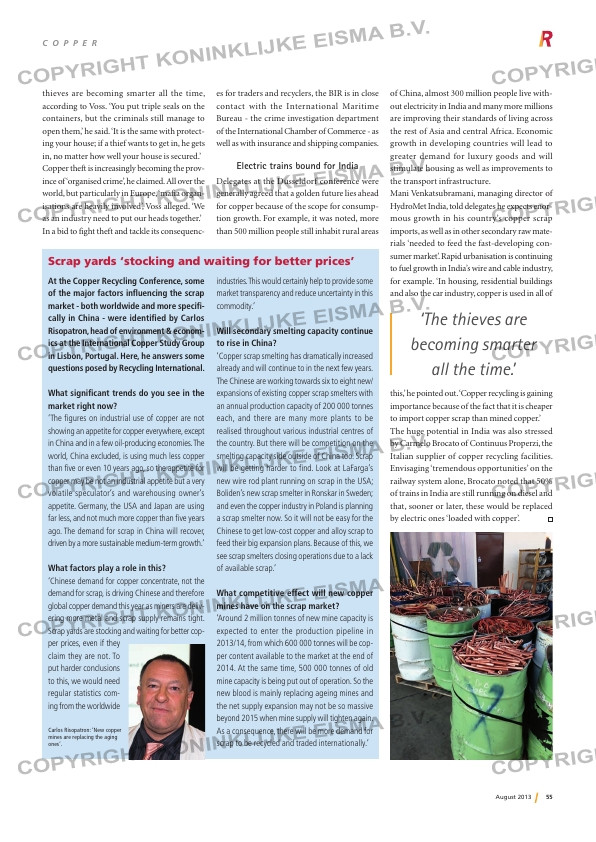Page 55 from: August 2013

55August 2013
C o p p e r
thieves are becoming smarter all the time,
according to Voss. ‘You put triple seals on the
containers, but the criminals still manage to
open them,’ he said. ‘It is the same with protect-
ing your house; if a thief wants to get in, he gets
in, no matter how well your house is secured.’
Copper theft is increasingly becoming the prov-
ince of ‘organised crime’, he claimed. All over the
world, but particularly in Europe, ‘mafia organ-
isations are heavily involved’, Voss alleged. ‘We
as an industry need to put our heads together.’
In a bid to fight theft and tackle its consequenc-
of China, almost 300 million people live with-
out electricity in India and many more millions
are improving their standards of living across
the rest of Asia and central Africa. Economic
growth in developing countries will lead to
greater demand for luxury goods and will
stimulate housing as well as improvements to
the transport infrastructure.
Mani Venkatsubramani, managing director of
HydroMet India, told delegates he expects enor-
mous growth in his country’s copper scrap
imports, as well as in other secondary raw mate-
rials ‘needed to feed the fast-developing con-
sumer market’. Rapid urbanisation is continuing
to fuel growth in India’s wire and cable industry,
for example. ‘In housing, residential buildings
and also the car industry, copper is used in all of
this,’ he pointed out. ‘Copper recycling is gaining
importance because of the fact that it is cheaper
to import copper scrap than mined copper.’
The huge potential in India was also stressed
by Carmelo Brocato of Continuus Properzi, the
Italian supplier of copper recycling facilities.
Envisaging ‘tremendous opportunities’ on the
railway system alone, Brocato noted that 50%
of trains in India are still running on diesel and
that, sooner or later, these would be replaced
by electric ones ‘loaded with copper’.
At the Copper Recycling Conference, some
of the major factors influencing the scrap
market – both worldwide and more specifi-
cally in China – were identified by Carlos
Risopatron, head of environment & econom-
ics at the International Copper Study Group
in Lisbon, Portugal. Here, he answers some
questions posed by Recycling International.
What significant trends do you see in the
market right now?
‘The figures on industrial use of copper are not
showing an appetite for copper everywhere, except
in China and in a few oil-producing economies. The
world, China excluded, is using much less copper
than five or even 10 years ago, so the appetite for
copper may be not an industrial appetite but a very
volatile speculator’s and warehousing owner’s
appetite. Germany, the USA and Japan are using
far less, and not much more copper than five years
ago. The demand for scrap in China will recover,
driven by a more sustainable medium-term growth.’
What factors play a role in this?
‘Chinese demand for copper concentrate, not the
demand for scrap, is driving Chinese and therefore
global copper demand this year as miners are deliv-
ering more metal and scrap supply remains tight.
Scrap yards are stocking and waiting for better cop-
per prices, even if they
claim they are not. To
put harder conclusions
to this, we would need
regular statistics com-
ing from the worldwide
industries. This would certainly help to provide some
market transparency and reduce uncertainty in this
commodity.’
Will secondary smelting capacity continue
to rise in China?
‘Copper scrap smelting has dramatically increased
already and will continue to in the next few years.
The Chinese are working towards six to eight new/
expansions of existing copper scrap smelters with
an annual production capacity of 200 000 tonnes
each, and there are many more plants to be
realised throughout various industrial centres of
the country. But there will be competition on the
smelting capacity side outside of China too. Scrap
will be getting harder to find. Look at LaFarga’s
new wire rod plant running on scrap in the USA;
Boliden’s new scrap smelter in Ronskar in Sweden;
and even the copper industry in Poland is planning
a scrap smelter now. So it will not be easy for the
Chinese to get low-cost copper and alloy scrap to
feed their big expansion plans. Because of this, we
see scrap smelters closing operations due to a lack
of available scrap.’
What competitive effect will new copper
mines have on the scrap market?
‘Around 2 million tonnes of new mine capacity is
expected to enter the production pipeline in
2013/14, from which 600 000 tonnes will be cop-
per content available to the market at the end of
2014. At the same time, 500 000 tonnes of old
mine capacity is being put out of operation. So the
new blood is mainly replacing ageing mines and
the net supply expansion may not be so massive
beyond 2015 when mine supply will tighten again.
As a consequence, there will be more demand for
scrap to be recycled and traded internationally.’
Scrap yards ‘stocking and waiting for better prices’
Carlos Risopatron: ‘New copper
mines are replacing the aging
ones’.
‘The thieves are
becoming smarter
all the time.’
es for traders and recyclers, the BIR is in close
contact with the International Maritime
Bureau – the crime investigation department
of the International Chamber of Commerce – as
well as with insurance and shipping companies.
Electric trains bound for India
Delegates at the Düsseldorf conference were
generally agreed that a golden future lies ahead
for copper because of the scope for consump-
tion growth. For example, it was noted, more
than 500 million people still inhabit rural areas
RI-6_Copper.indd 55 01-08-13 11:47



